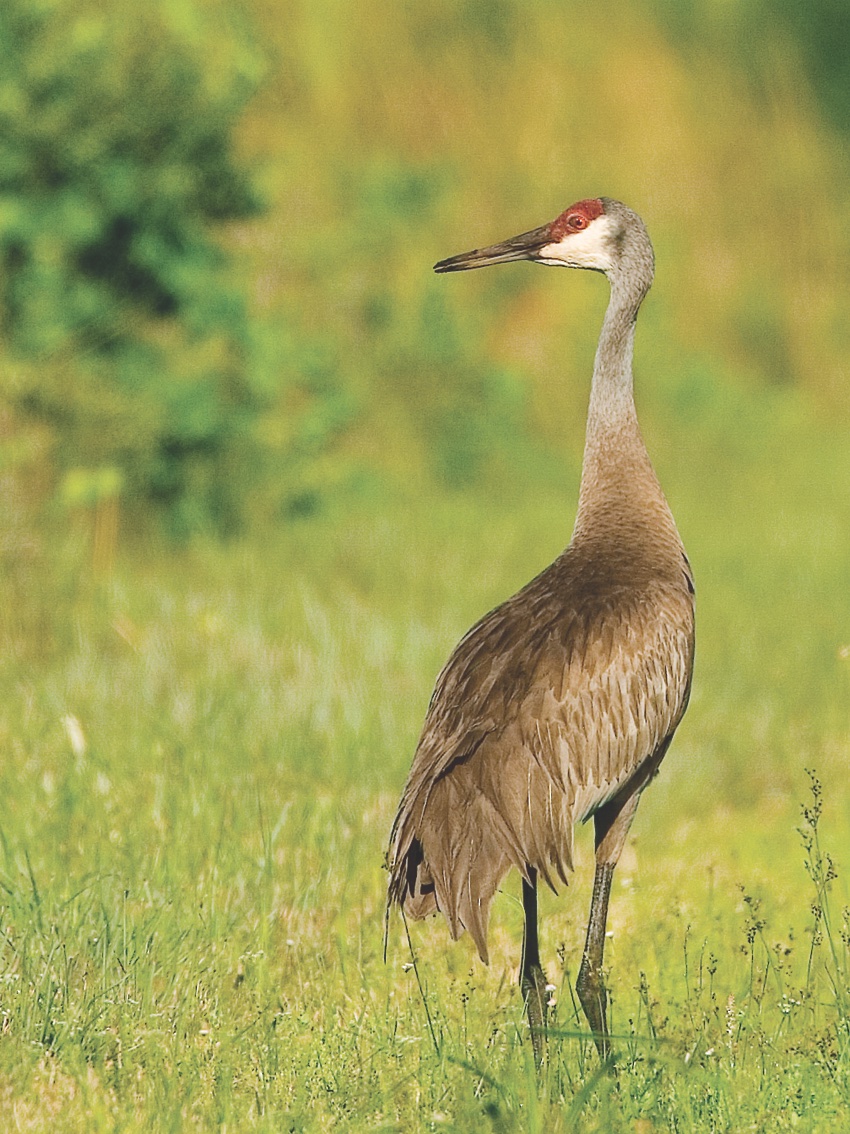Sandhill Crane Migration observed March 14-15, 2023
By Bonita Oliva
On the morning of March 14, 2023, Bonita Oliva, Woodston; Kenna Vincent, Hill City; and Kim Perez, Hays, traveled to Kearney, Neb., to observe some of the biannual Sandhill Crane migration. Bonita has visited this area several times over the past ten years to witness what National Geographic calls one of North America’s “greatest wildlife phenomena” and was excited to share this with fellow bird watchers. They traveled north on Nebraska Highway 10 through Minden and intersected L 50A south of the Platte River, which is prime crane viewing country. The Iain Nicolson Audubon Center at Rowe Sanctuary is located in this area. The women quickly stopped to verify their reservations for the evening’s guided blind tour. They had not driven far before they came upon a dozen cars parked on both sides of the gravel road. People were everywhere with cameras, some with eighteen- inch lenses, taking photos. This is a favorite meadow where cranes can usually be found. While stopped, the women rolled down the windows to listen to the sounds made by the cranes, called purring. This soothing sound can be heard throughout the area unless a strong wind blows.
The Platte River between Kearney and Grand Island, a distance of 42.5 miles, is the section of the river where most of the two subspecies of Sandhill Cranes pass during this migration. About sixty percent are Lesser Sandhill Crane. They are smaller and are found in the western portion of the migration route. They may fly 5,000 miles from the southwestern states and Mexico to Alaska and across the Bering Straits to nest in Siberia. The other forty percent are the larger giant Greater Sandhill cranes that nest throughout Canada and fly toward the eastern portion of the migration route. The two may intermingle during migration. During spring migration, which begins mid-February and runs through April, peaking in mid-March, approximately 100,000 cranes pass through the area. The larger endangered Whooping Crane also uses the route. They usually migrate a bit later than Sandhill Cranes.
This area is an essential stopover for migrating cranes to rest and replenish their energy reserves. The broad, shallow channels in the Platte provide abundant, vegetation-free sandbars where the cranes roost at night and are relatively safe from predators. They fly to nearby meadows and cornfields at dawn and spend the day feeding on insects, worms, snails, and plant tubers. However, waste corn in the cornfields, pastured during the winter, provides the main staple of their diets. They remain in the area for about a month to “fatten up” before continuing their journeys northward. Fall migration occurs from October through December. This migration is less spectacular. However, there is evidence that cranes are among the oldest surviving species of birds, and their migrations have been going on for thousands of years. Nebraska is the only state along the migration route that does not permit hunting.
The area has two visitor centers, the Iain Nicolson Audubon Center at Rowe Sanctuary and The Crane Trust, which focus on conserving the Platte River ecosystem and the birds that rely on it. Both offer guided tours to visitors who wish to watch the cranes from viewing blinds next to the river. In addition, both institutions have live web cameras in the river where the cranes roost. Crane lovers can access these webcams at home on their cell phones and watch the action on the river. Cranes interact socially on the river, but they also are more likely to engage in preening there, using their bills to clean and arrange their feathers, keeping them in the perfect condition necessary for flight. They also bathe in the river, much like robins bathe in birdbaths.
After confirming their reservations and checking out the gift shop, the women continued to Kearney to have lunch at the Sawannee Thai Cuisine restaurant near the University of Nebraska Kearney Campus. The women then returned to the highway south of the river and stopped at East Park, where Bonita spent the night on her first trip to view the cranes. It is a State Park with camper pullouts and several fishing ponds and is the end of a recreational trail from Kearney that crosses a railroad bridge over the Platte River. This makes a great viewing platform for crane watching. The women made the short hike to the bridge on a recently poured concrete trail. Continuing around the circle drive, Kim spotted a large flock of cranes on an adjacent cornfield through the trees. They could often be seen jumping in pairs, bowing, and flapping their wings, known as socializing. Unmated birds are checking out prospective mates. Cranes mate for life and live as long as 20 years. Finally, the women returned to Kearney to check into their hotel and dress warmly for their evening in a blind near the Iain Nicholson Audubon Center.
Returning to the Center, the women joined about 100 others for the evening tour at 6 o’clock. The nine volunteer guides were introduced. They came from McCook, Omaha, and beyond. Most are retired, and all have crane expertise. The participants were cautioned not to talk; flash cameras and phones were prohibited. The group was divided into thirds. Bonita, Kenna, and Kim were in the first group and walked to the most distant blind, a wooden structure built next to the river with a long narrow window facing the river. The group was protected from the south wind and moderate temperatures. Numerous cranes in “kettles” (groups) of varying sizes flew in the area and gradually began landing on the distant north side of the channel. The process continued as the sun sank, the cranes slowly expanding southward toward the blind. Several deer were spotted on the north shore walking among the cranes without disturbing them. When it was nearly dark, the cranes were within 20 yards of the blind. Then someone turned on a flashlight! A thousand cranes were gone in an instant, ruining the experience for everyone in the blind. Thirty minutes later, it was totally dark and time to return to the Center. Small flashlights with red lenses were passed to members of the group to enable them to see the path. The red light is invisible to cranes. A guide told Kim that she had seen the cranes come to within a few feet of the blind to roost. The women were disappointed they had not had a closer view of the cranes.
Rising early the following day and after a quick breakfast at the motel, the women traveled east to a public viewing platform across the river at the Gibbon Exit. The parking lot was full when they arrived. When they opened the car doors, the purring of the cranes surrounded them and filled the countryside. Joining the crowd on the platform, most of which had a camera in hand, the women could see the distant north side of the river was the solid grayblue color of thousands of cranes. Numerous kettles were flying everywhere. Then huge bunches began rising from the river, and the sound was so loud you could not hear your neighbor talking. Everyone was silent and in awe. It is an amazing and humbling experience.
Afterward, the women drove gravel back roads by cornfields and stopped to watch the birds. Then they traveled east to The Crane Trust, which also has a large gift shop and sponsors an exhibit of photographers and artists who feature cranes in their work. A nature walk leads to the river and passes a pasture with a herd of buffalo, a viewing tower, and arrives at a walkway across the river. Bonita came here in August 2017 to view the sun's total eclipse. Finally, the women returned to Kearney to have hamburgers at Cunningham’s Journal, so called because the building once housed a newspaper business. On their return homeward, they stopped to see the restored Home on the Range Cabin where Brewster M. Higley wrote a poem describing his feelings about the area in the early 1870s. He then asked a friend to compose music to accompany it. It became ‘Home on the Range’ and the Kansas State Song. The Peoples Heartland Foundation privately owns the site and has placed several excellent signs explaining the site's history. A 6th Annual Spring Celebration is planned for April 22 and 23, 2023, in observance of the 150th Anniversary of the writing of the poem, which became the State Song of Kansas.
The annual pilgrimage to Nebraska to witness the crane migration is a Rite of Spring for Bonita. Because of Covid, she had not experienced the phenomena for several years. This part of Kansas is on the migration flyway, and Kirwin National Wildlife Refuge is occasionally used as a stopover for Sandhill Cranes and Whooping Cranes. Bonita lives about fifteen miles from the Kirwin Dam. Two years ago, when Whooping Cranes were reported at Kirwin Lake, she spotted a kettle of seven or eight Whooping Cranes circling over the farm. It was a magical, unforgettable experience! To be outside during the few minutes when the magnificent birds are circling overhead, and catching a glimpse of movement or a fleeting sound! A God-given Gift! Occasionally, she will hear and spot a kettle of Sandhill Cranes overhead during spring migration. It is always a wonderful, inspiring moment.




